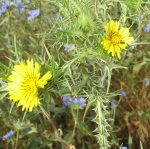A lso known as spotted oyster thistle, this annual herb is native of the Mediterranean region including southern Europe, southwest Asia, northern Africa, and the Canary Islands where it grows in fields and disturbed sites of woodlands, shrublands, and deserts. It is a member of the aster family, Asteraceae, that also includes daisy, yarrow, and lettuce. The plant grows 3’3″ tall and has a rosette of soft leaves and a stem carrying uninterrupted prickly wings with a white marginal vein. Pinnately incised, grayish-green leaves along the stem are 3.5-5.5″ long, obovate, and rigid, and have dentate margins tipped with spines and edged with white a vein. Yellow flowerheads less than 1″ across appear singly or in clusters of 2-4 in leaf axils or at the tip of the stems in summer. Each flowerhead includes black hairs and is subtended by 5 leaf-like, oval to lanceolate bracts that are pinnately divided, spine-tipped, and have white margins. The fruit is an achene with no pappus. Photo Credit Iorsh Wikipedia
lso known as spotted oyster thistle, this annual herb is native of the Mediterranean region including southern Europe, southwest Asia, northern Africa, and the Canary Islands where it grows in fields and disturbed sites of woodlands, shrublands, and deserts. It is a member of the aster family, Asteraceae, that also includes daisy, yarrow, and lettuce. The plant grows 3’3″ tall and has a rosette of soft leaves and a stem carrying uninterrupted prickly wings with a white marginal vein. Pinnately incised, grayish-green leaves along the stem are 3.5-5.5″ long, obovate, and rigid, and have dentate margins tipped with spines and edged with white a vein. Yellow flowerheads less than 1″ across appear singly or in clusters of 2-4 in leaf axils or at the tip of the stems in summer. Each flowerhead includes black hairs and is subtended by 5 leaf-like, oval to lanceolate bracts that are pinnately divided, spine-tipped, and have white margins. The fruit is an achene with no pappus. Photo Credit Iorsh Wikipedia
There are many spiny plants in the Holy Land and they are various called thistles, brambles, briers, nettles, and thorns/thorn bushes or trees. The passage from Isaiah below may refer to a combination of Syrian thistle (see entry) and spotted golden thistle, Solymus maculatus, which is common in fields and waste places throughout the Holy Land.
Isaiah 34:13 (NIV) God expresses his indignation against the people of all nations and tells of the desolation of the land.
“Thorns will overrun her citadels, nettles and brambles her strongholds. She will become a haunt for jackals, a home for owls.”
Spotted golden thistle likes semi-shade to full sun and average, medium moist to dry, well-drained soil in USDA Hardiness Zones 6-9. Propagation is by seed.
The genus name, Scolymus, is the Latin name for the Spanish oyster plant. The specific epithet, maculatus, is the Latin word meaning stained or spotted.